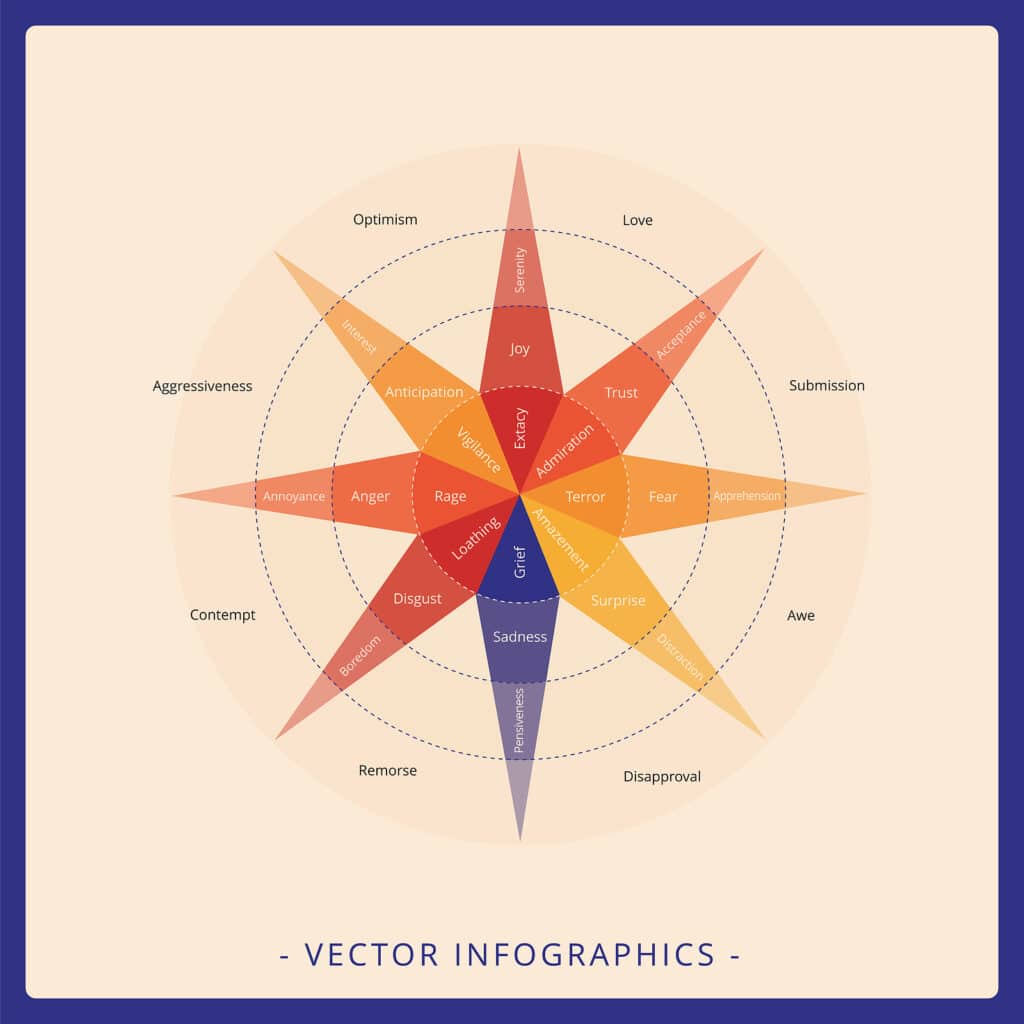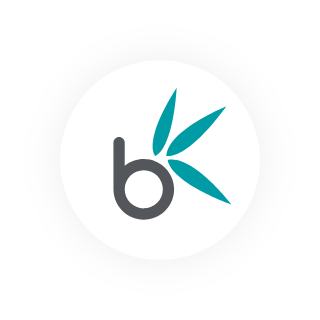The Power of Emotional Words in Marketing
Emotions drive many of our decisions throughout the day, from choosing what to eat for lunch, to what we say to colleagues and strangers, to what we watch in the evening. Our emotional engagement drives us to act, make decisions, and spread messages to each other.
Appealing to the emotions of a reader is therefore a powerful tactic in writing, from novelists wrapping readers up in a good story, to marketers engaging potential customers in their product or service.
In this guide we’ll be looking at emotional words, words specifically used to trigger an emotional response in a reader, engaging them, whether that’s by scaring them, making them happy, or making them angry. We’ll look through some examples of emotional words, and explore how they can be used to make compelling copy.
What Are Emotional Words?
There have been many different attempts to categorise emotions over the years, with the example above taken from psychologist Robert Plutchik. The meaning of emotional words is any words that can be used to help elicit an emotional response from a reader. They can either describe a specific emotion, like “anger”, “happiness” or “sadness”, or be a word that has connections to a specific emotion for readers, like “terrifying”, “messy”, or “agonising”.
Emotive language is used throughout everyday speech, for telling stories, trying to convince others to see your point of view, or trying to encourage someone. Using psychological tools like the one above can allow you to create a list of emotions to target, and get a more thorough understanding of emotions.

How Can Emotional Words Benefit Writing?
All writing can benefit from the use of emotional words, whether that’s engaging the readers of a novel in the world of the characters, engaging someone in an opinion through a compelling essay, or triggering a powerful emotional response through advertising. Let’s look at some examples:
Example 1: Fiction
Here is a fiction extract with no emotional words:
“John walked over to the window, touching the glass with his hand. He looked out over the city skyline.”
While it has a certain minimalist flair, it leaves the reader with little insight or engagement. Here’s a similar extract that has been rewritten to prioritise emotional words:
“John was incensed, collapsing towards the window. Panicked, he steadied himself with his hand, hyperventilating as he looked out over the dark city”
Overselling it a little, but suddenly you have an idea about John, the sort of person he is and why he’s behaving like this. Emotional language can help you to bond with characters, hate villains, and generally invest in the story as a reader. People often talk of disappearing into books, of finding themselves transported away, and emotional words are an important part of this process.
Example 2: Non-Fiction
Here is an example of how a non-fiction text can sound without emotional words:
“The markets closed today at their lowest ever total”
And here’s the same sentence that has been rewritten to include some more emotional language:
“Catastrophic collapse as markets plunge to devastating historic low”
While communicating the same basic message, you can use emotional words to cause anxiety and sadness, engaging a reader within a story. This can be used within a tabloid newspaper, a historical non-fiction book, an essay arguing for a certain point of view, and many other forms.
How Are Emotional Words Used in Marketing?
Emotional trigger words are frequently used in marketing. The central goal of marketing is to sell goods, services, or ideas, and emotional triggers can be an effective way to do all three. As stated at the beginning, we are essentially emotional creatures, rarely driven to purely logical decision making. The specific emotions you target through advertising can vary wildly, and work for different objectives.

What Emotions Can You Target with Emotional Words?
While marketing can target any emotion, you’ll ultimately be looking for an actional response from a consumer. Emotional marketing can drive a variety of responses, whether that is buying a product, paying for a service, or engaging with a concept or political movement. Emotional words can also enhance the use of power words.
In this section, we’ll look at the four basic emotions targeted through feeling words, though obviously there is a more complex list of feelings that can be targeted, such as lust, envy, guilt, and others.
Happiness
Probably one of the key emotional targets within marketing is happiness, or related emotions like excitement, desire, or anticipation. For example. words like “beautiful”, “thrilling”, “awe-inspiring”, “delicious”, and “comforting” are used to elicit a positive emotional response. This can be used for products like food, clothing, cars, and many more. It can also be used for services like holidays, museums, or teeth whitening.
You can even use emotional marketing to convince a target audience to engage in ideas through happy emotional words, such as Obama’s all-conquering “Hope”, or for a slightly more obscure example Huey Long’s promise to make “Every man a king”. Both of these are designed to stir up an emotional response in a reader, to engage them through positive emotions in the promise of a brighter future.
Sadness
Sadness can be a valuable emotion within the marketing of companies like charities. Sadness can make us connect with people across the world, showing empathy. Charities will use emotional words like “desperate”, “miserable”, “destitute”, and “scared” in their marketing copy, to help engage those who read it, making them more likely to donate money.
Larger companies can connect sadness about an issue to positive actions caused by their business, as in “the rainforests have been devastated by greedy industrialists, which is why we’re happy to only use sustainably sourced wood in our products”. Evoking sadness about a topic before showing yourself as the solution can be an effective strategy.
Anger
Anger can be a great way to get a click, but isn’t always the most sustainable way to get positive engagement in your product. Like sadness, it can be an effective way to engage people in a charity, by making them angry about the cause the charity is working against. Anger is often used in political advertising, with emotional language like “disgusting”, “outrageous”, “libellous”, and “reprehensible” used to encourage people to take a stand against a candidate, industry, or issue by voting for a specific candidate.
Fear
Using emotional words to inspire fear in your readers can be a great way to market certain products, services, and ideas. Fear can be used to sell safety or security products, with emotional words like “danger”, “risk”, “devastation”, or “uncertain” making readers afraid of the consequences should they not make a purchase. It can also create a sense of urgency, by implying limited time to buy a product or service. Fear is often used for government schemes, such as anti-smoking advertising or safe driving advertising. Emotional marketing can also be used for political campaigning, to try and make readers afraid about a topic or candidate.

What Are Some Great Emotional Language Words?
Here are just a few examples of the great emotion words that can be used within writing, helping to get an emotional response from a reader. Professional copywriters will often keep a list of strong emotion words, allowing them to get inspiration when they need it.
Happiness
- Comfortable
- Delightful
- Encouraging
- Exhilarating
- Funny
- Joyful
- Joyous
- Lighthearted
- Serene
- Thrilling
Sadness
- Heartbreaking
- Disappointing
- Mournful
- Depressing
- Tearjerking
- Heartwrenching
- Sombre
- Bleak
- Wistful
- Gloomy
Anger
- Disgusting
- Evil
- Wretched
- Awful
- Unfair
- Disproportionate
- Reckless
- Hedonistic
- Contemptible
- Atrocious
Fear
- Terrifying
- Demonic
- Aberrant
- Preying
- Alarming
- Apocalyptic
- Menacing
- Nightmarish
- Overwhelming
- Embarrassing
How Do We Use Emotional Words in Our SEO Copywriting?
At Bamboo Nine, our skilled team of SEO copywriters (hello) work on content for the websites of our clients. This content can be designed to sell specific items or services, or to drive engaged traffic to their website, building brand awareness.
We use emotional words and phrases in our calls to action, helping to entice readers to read our articles. Within the pages, we can use emotional words to convince a reader that a specific product will increase their happiness. We can also use a variety of emotional words in our traffic-driving content, designed to make it compelling and sharable.
Phrases like “Terrible mistakes everyone makes..” or “Avoid embarrassment with these simple tips” in a headline can help to engage a reader with the article. We work with each of our clients on a tone of voice, helping to tailor our content marketing around the desired audience, and the voice of the brand. We also work in social media, using emotional words to engage a brand’s audience and drive sales.
If you are interested in the possibilities of SEO, including SEO copywriting for your business, read a little more about what Bamboo Nine can offer, or contact us today to speak to a member of our team.



